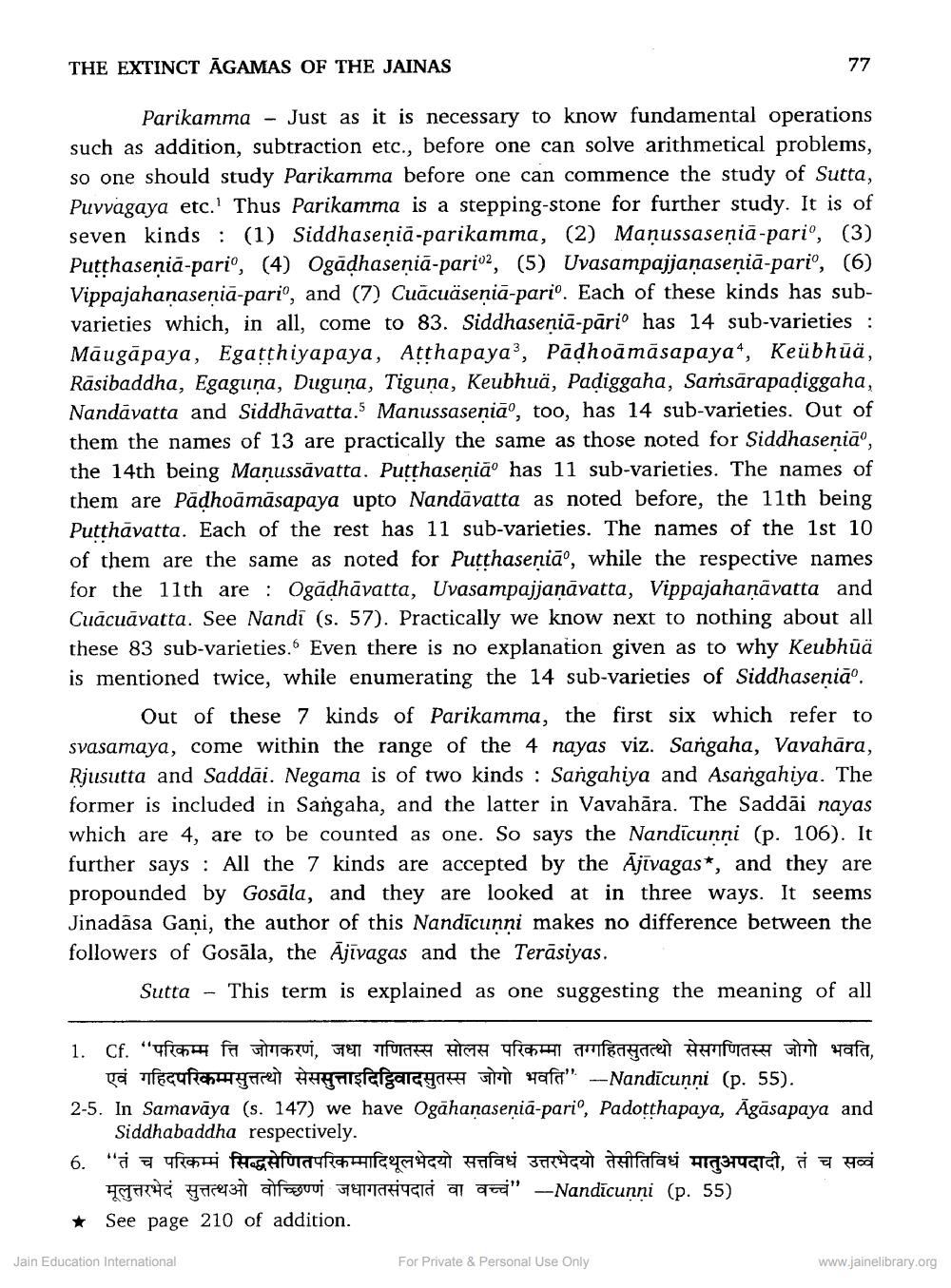________________
THE EXTINCT ĀGAMAS OF THE JAINAS
77
Parikamma - Just as it is necessary to know fundamental operations such as addition, subtraction etc., before one can solve arithmetical problems, so one should study Parikamma before one can commence the study of Sutta, Puvvagaya etc. Thus Parikamma is a stepping-stone for further study. It is of seven kinds : (1) Siddhaseņiā-parikamma, (2) Maņussaseņiā-pari', (3) Putthaseņiā-pari', (4) Ogādhaseņia-pario, (5) Uvasampajjaṇaseņiā-pari', (6) Vippajahanasenia-pari', and (7) Cuācuäseniā-pari'. Each of these kinds has subvarieties which, in all, come to 83. Siddhaseniā-pārio has 14 sub-varieties : Māugāpaya, Egatthiyapaya, Atthapaya', Padhoāmāsapayao, Keübhūä, Rāsibaddha, Egaguna, Duguņa, Tiguna, Keubhuä, Padiggaha, Samsārapadiggaha, Nandāvatta and Siddhāvatta. Manussasenia', too, has 14 sub-varieties. Out of them the names of 13 are practically the same as those noted for Siddhasenia", the 14th being Manussävatta. Putthasenião has 11 sub-varieties. The names of them are Pädhoāmāsapaya upto Nandāvatta as noted before, the 11th being Putthāvatta. Each of the rest has 11 sub-varieties. The names of the 1st 10 of them are the same as noted for Putthasenia', while the respective names for the 11th are : Ogādhāvatta, Uvasampajjaņāvatta, Vippajahaņāvatta and Cuācuāvatta. See Nandi (s. 57). Practically we know next to nothing about all these 83 sub-varieties. Even there is no explanation given as to why Keubhūä is mentioned twice, while enumerating the 14 sub-varieties of Siddhaseniño.
Out of these 7 kinds of Parikamma, the first six which refer to svasamaya, come within the range of the 4 nayas viz. Sangaha, Vavahāra, Rjusutta and Saddai. Negama is of two kinds : Sangahiya and Asangahiya. The former is included in Sangaha, and the latter in Vavahāra. The Saddāi nayas which are 4, are to be counted as one. So says the Nandicunni (p. 106). It further says: All the 7 kinds are accepted by the Ajivagas*, and they are propounded by Gosāla, and they are looked at in three ways. It seems Jinadāsa Gani, the author of this Nandīcunni makes no difference between the followers of Gosāla, the Ājivagas and the Terasiyas.
Sutta - This term is explained as one suggesting the meaning of all
1. Cf. "fich far o ui, 578 Tura HSE Of Tiferent force GT wafa,
va feguich e t Hartsfigalgiak irit afa" --Nandīcunni (p. 55). 2-5. In Samavāya (s. 147) we have Ogāhanaseņiā-pario, Padotthapaya, Āgāsapaya and
Siddhabaddha respectively. 6. "तं च परिकम्मं सिद्धसेणितपरिकम्मादिथूलभेदयो सत्तविधं उत्तरभेदयो तेसीतिविधं मातअपदादी, तं च सव्वं
TATUS HT12377 alfreguuj ETICHETTI ai aca" -Nandicunni (p. 55) * See page 210 of addition.
Jain Education International
For Private & Personal Use Only
www.jainelibrary.org




